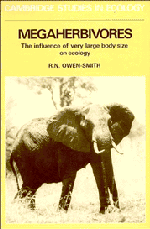Book contents
- Frontmatter
- Contents
- Preface
- 1 Prologue
- 2 Morphology, evolutionary history and recent distribution
- 3 Food and other habitat resources
- 4 Space–time patterns of habitat use
- 5 Body size and nutritional physiology
- 6 Body size and feeding ecology
- 7 Social organization and behavior
- 8 Life history
- 9 Body size and sociobiology
- 10 Body size and reproductive patterns
- 11 Demography
- 12 Community interactions
- 13 Body size and population regulation
- 14 Body size and ecosystem processes
- 15 Late Pleistocene extinctions
- 16 Conservation
- 17 Epilogue: the megaherbivore syndrome
- Appendixes
- References
- Index
7 - Social organization and behavior
Published online by Cambridge University Press: 01 June 2011
- Frontmatter
- Contents
- Preface
- 1 Prologue
- 2 Morphology, evolutionary history and recent distribution
- 3 Food and other habitat resources
- 4 Space–time patterns of habitat use
- 5 Body size and nutritional physiology
- 6 Body size and feeding ecology
- 7 Social organization and behavior
- 8 Life history
- 9 Body size and sociobiology
- 10 Body size and reproductive patterns
- 11 Demography
- 12 Community interactions
- 13 Body size and population regulation
- 14 Body size and ecosystem processes
- 15 Late Pleistocene extinctions
- 16 Conservation
- 17 Epilogue: the megaherbivore syndrome
- Appendixes
- References
- Index
Summary
Introduction
Patterns of social organization reflect the cooperative and competitive interactions occurring among animals within local populations relating to survival and reproduction. Generally different age/sex classes differ in their spatial dispersion, i.e. group membership and the spatial relationships both within and between groups. Other social relationships may be evident from the patterns of behavior displayed in encounters, for example those signifying dominant/subordinate relations. Dominance is particularly a feature of adult males, which are inevitably competitors for reproductive opportunities. Females in turn may exert some selection over the sire of their offspring. Anti-predator responses are also appropriately considered in this chapter, since the affiliative relationships established among adult females serve largely to reduce the risks of predation, not only for self but also for progeny.
Group structure
The term group refers to a close spatial association between individuals. However, socially the temporal cohesion of the group is relatively more important than short-term spatial proximity. Groups may vary in size, and in the age/sex classes of animals composing them. Different groups may either move independently of one another, or tend to associate together, or space themselves out with respect to other groups. Grouping patterns may furthermore change seasonally, particularly in relation to variations in reproductive activity.
Elephants
Among African elephants, the nuclear group comprises an adult female together with 1–3 immature progeny of varying ages. However, generally one finds 2–4 mothers plus young associated together to form family units typically numbering about 4 to 12 animals (Fig. 7.1).
- Type
- Chapter
- Information
- MegaherbivoresThe Influence of Very Large Body Size on Ecology, pp. 101 - 132Publisher: Cambridge University PressPrint publication year: 1988



